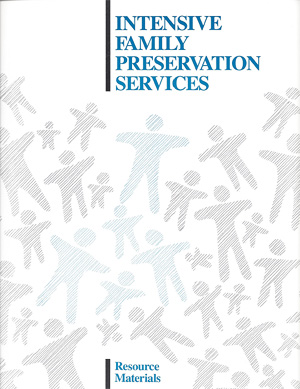Presented at the IFPS 40th Anniversary, July 18, 2014
 I have been asked to talk briefly about what is happening today in IFPS and Homebuilders®. Those of you who know me—and many of you do—know that being brief is not my strong suit, but I will try very hard to briefly summarize the current state of IFPS/Homebuilders and some of the exciting new developments.
I have been asked to talk briefly about what is happening today in IFPS and Homebuilders®. Those of you who know me—and many of you do—know that being brief is not my strong suit, but I will try very hard to briefly summarize the current state of IFPS/Homebuilders and some of the exciting new developments.
First, however, I have to go back in time to 1994 to provide some context to what’s happening today. In 1994, Priscilla Martens, Director of the National Family Preservation Network (NFPN), surveyed states to gather information about statewide implementation of Intensive Family Preservation Services (IFPS). Some of you may recall that at one time, these services were called “family preservation services”—FPS, and then later (I can’t recall when), the “I”—Intensive” was added and these services became Intensive Family Preservation Services (IFPS). In some states these services are still referred to as “family preservation”, and in others, “intensive family preservation”.
In 1994, the survey showed that a half dozen states had implemented IFPS/FPS statewide. This was pretty amazing. After a fairly short time—less than 8 years—statewide implementation was achieved in a number of states. This accomplishment was the direct result of Peter Forsythe’s vision and strategic approach to systems change, and the work of many of you here today, who were involved at many different levels.
I want to rewind a little farther back to 1987, when New Jersey became the first state outside of Washington State to set a goal of statewide implementation of IFPS. In 1987 New Jersey began a very thoughtful and well planned implementation—beginning with four counties (rather than the entire state at once), with plans to expand over the next few years. I have fond memories of driving with Maureen Braun from Hudson County in the north to Cape May in the south for a week of hiring interviews with potential IFPS supervisors and therapists using the Homebuilders® interview role play. We didn’t have as many questions or the writing exercises we use today, but we used a very similar family “role play”. Out of that week of interviews unfortunately, we identified only one person to hire. But what we hope happened, and I think it did, was that the agencies learned more about the program and what we were looking for in potential staff, and began to understand the importance of “job fit”—the idea that it is not just a certain degree or experience that qualifies people for the IFPS job, but that factors such as values, lifestyle, and flexibility are essential for someone to “fit” with this type of job. This unusual strategy of role playing family members and seeing how applicants respond to them, and feedback helped them better understand the service and the need for job fit.
Back to today. We actually—hopefully —have improved our interview process based on years of experience, and many examples of what we might call “mis-hires”. We ask a lot more questions and gather more information, and we still do a role play—which is really the heart of the process. But now, instead of driving up and down a state, we do it with other states via Skype. We recently finished interviews via SKYPE with15 to 20 applicants in the Washington D.C. area as part of our start up process for a new team there. So, technology has become our friend, even though many of us fought it.
In 2006, the Washington State Institute for Public Policy (WSIPP) issued a report, which Ray Kirk and others here spoke about. This report focused a big spotlight on fidelity. The WSIPP report really highlighted the importance of fidelity, and resulted in placing a new focus on the Homebuilders® standards, which had been in place since the 1990s. In 2006 we (IFD) decided to focus on how we would measure these standards—what the fidelity measures would be, and the indicators that people are meeting the standards. (Asking for instance—does everything have to be 100% to meet a standard?) After a couple of years and many hours of meetings, we developed 23 standards and 17 pages of fidelity measures. We now share them with every state we work with. Some of those people are here today and they know the standards and fidelity measures very well.
The fidelity measures are really important for program implementation, as well as the other pieces: “What are our methods for measuring (the standards)? And, where are we going to get the data?” We have some data that are easy to count (e.g. number of face to face hours, response time, etc.) and a lot of data and information that are much more difficult to measure. This includes data/information/evidence of teaching, using cognitive behavioral interventions, engagement, and motivating families. We had to develop strategies to measure fidelity to the model and to help states then implement the model at the level of fidelity on which we were focused.
Moving a little forward in time. Some of you may know that for years we didn’t give permission to program/agencies to use the name Homebuilders®, because we couldn’t insure they would maintain fidelity to the model. As a result there were all kinds of creative names for IFPS and FPS programs all over the country: Home Ties, Family Ties, Family Options and about five versions of Families First.
In 2008, we began allowing other organizations to use the name Homebuilders® based on our ability—and theirs—to measure model fidelity. Today, there are 28 Homebuilders® programs/teams across the country with more being developed over the next year. Right now, there are:
- Twelve teams in Washington State including a team, through Washington’s mental health system, that is focused on trying to prevent psychiatric hospitalization and residential treatment. Monica Wafstet-Solin, one of our long-time staff members, heads up that program.
- Nine teams in the state of Indiana, which was one of the first states to be a laboratory for implementing the fidelity measures and standards.
- Four teams in Louisiana, with hopefully more on the horizon.
- Two teams in Broward County, Florida, an interesting privatization experiment that is going well.
- Washington D.C. is hopefully coming on line this month with one team and 3 more in 2015.
- A team in Connecticut just started 2 weeks ago.
- An exciting new team in northern British Columbia, which will be within a First Nations organization and serve First Nations/Aboriginal families.
- Two teams will be starting in Allegheny County, Pennsylvania later this year.
One of the tools we now have, which is instrumental in this implementation and development process—and this is why we’re now saying, “Technology is our friend,”—is a web-based client data and documentation system that has made it much easier at the program level, for therapists, supervisors, administrators, researchers, and for our consultants to always be kind of “peering” online at what people are doing—referrals, safety plans, and everything else involved in the intervention
So, we’re back now to 2014. NFPN has completed another survey that shows that there are now at least 12 states with statewide IFPS programs as well as many others that are not statewide. These states together are serving over 11,000 families.
So there has been and continues to be movement and new developments in IFPS —and it’s exciting.
Posted by Peg Marckworth



 I have been asked to talk briefly about what is happening today in IFPS and Homebuilders®. Those of you who know me—and many of you do—know that being brief is not my strong suit, but I will try very hard to briefly summarize the current state of IFPS/Homebuilders and some of the exciting new developments.
I have been asked to talk briefly about what is happening today in IFPS and Homebuilders®. Those of you who know me—and many of you do—know that being brief is not my strong suit, but I will try very hard to briefly summarize the current state of IFPS/Homebuilders and some of the exciting new developments.